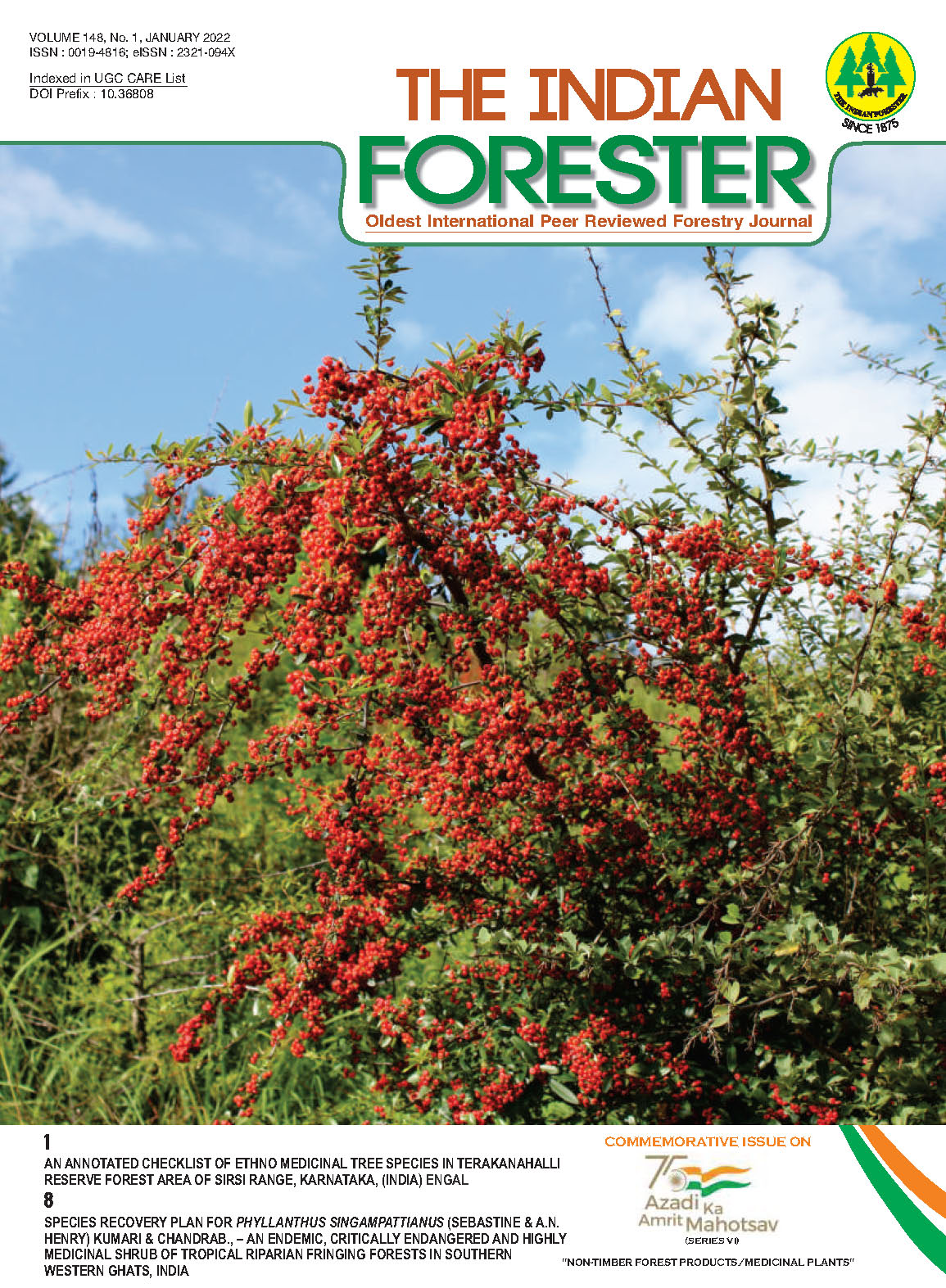Medicinal Plants used for the Traditional Management of Skin Disorders in Doodpathri area of Budgam, Jammu and Kashmir
DOI:
https://doi.org/10.36808/if/2022/v148i1/155608Keywords:
Skin Disorders, Medicinal Plants, Indigenous People, Doodpathri, Budgam.Abstract
Skin diseases are a major health concern in present world. These diseases effect all the individuals irrespective of age and gender. The aim of the present study was to document the ethnomedicinal information of plants used to treat various skin disorders in Doodpathri area of district Budgam of Jammu and Kashmir. This is the first ever ethnomedicinal study of therapeutic herbs utilized by the indigenous people in the present study area for the treatment of skin disorders. In this study a total of 36 medicinal plants belonging to 34 genera and 25 families were recorded to be used for skin disorders by the indigenous people. Asteraceae was found to be the dominant family with a species contribution of nine species. It was found that there is a very little information available about cultivation, sustainable harvesting and uses of these medicinal plant species. There is a dire need to create awareness among the local and government communities for the preservation of medicinal flora of the area.References
Anzar A.A., Rashid I., Reshi Z., Dar G.H. and Wafai B.A. (2007). The Alien Flora of Kashmir Himalaya. Biological Invasions, 9: 262-292.
Ara S. and Naqshi A.R. (1992). Ethnobotanical Studies in Gureiz Valley. Journal of Economic and Taxonomic Botany, 17(3): 657-678.
Dar G.H., Bhagat R.C. and Khan M.A. (2002). Biodiversity of Kashmir Himalaya. Valley Book House, Srinagar.
Dar, G.H., VirJee, Kachroo P. and Buth G.M. (1984). Ethnobotany of Kashmir-I, Sind Valley. Journal of Economic and Taxonomic Botany, 5(3): 668-675.
Eddouks M., Bidi A., El Bouhali B., Hajji L. and Zeggwagh N.A. (2014). Antidiabetic plants improving insulin sensitivity. Journal of Pharmacy and Pharmacology, 66(9): 197-214.
Garnatje T., Peñuelas J. and Vallès J. (2017). Ethnobotany, phylogeny, and 'omics' for human health and food security. Trends in Plant Science, 22(3): 187-91.
Hooker J.D. (1879).The Flora of British India, Vol 2. L. Reeve and Co., Ashford, Kent, England. 78-99 p.
Kapoor L.D. (1989). Handbook of Ayurvedic Medicinal plants. CRC, USA. 424 p.
Khan M.P.Z., Ahmad M., Zafar M., Sultana S., Ali M.I. and Sun H. (2015). Ethnomedicinal uses of edible wild fruits (EWFs) in Swat Valley, northern Pakistan. Journal of Ethnopharmacology, 173: 191-203.
Khuroo A.A., Malik A.H., Dar A.R., Dar G.H. and Khan Z.S. (2007). Ethno-veterinary medicinal uses of plant species by the Gujar tribe of the Kashmir Himalaya. Asian Journal of Plant Sciences, 6(1): 148-152.
Malik A.H., Khuroo A.A., Dar G.H. and Khan Z.S. (2011). Ethnomedicinal uses of some plants in the Kashmir Himalaya. Indian Journal of Traditional Knowledge, 10(2): 362-366.
MartÃnez G.J. and Barboza G.E. (2010). Natural pharmacopoeia used in traditional Toba medicine for the treatment of parasitosis and skin disorders (Central Chaco, Argentina). Journal of Ethnopharmacology, 132(1): 86-100.
Miller A.G.and Nyberg J.A. (1995).Collecting Herbarium Vouchers. Royal Botanic Garden, Edinburgh EH3 5LR, U.K. 561-573 p.
Navchoo I.A. and Bhat G.M. (1994). Studies on the medicinal plants used by Gujjar, a backward tribe of Jammu and Kashmir. In: Sahni K.C. ed. Advances in Plant Science Research. Bishen Singh and Mahendra Singh, Dehradun, India. 191-203 p.
Navchoo I.A. and Kachroo P. (1995). Flora of Pulwama, Kashmir. Bishen Singh and Mahendra Pal Singh, Dehradun.
Rai L.K., Prasad P. and Sharma E. (2000). Conservation threats to some important plants of the Sikkim Himalaya. Biological Conservation, 93: 27-33.
Singh J.B. and Kachroo P. (1994). Forest Flora of PirPanjal Range: North Western Himalaya. Bishen Singh Mahendra Pal Singh, Dehradun, India.
Singh N.P., Singh D.K. and Uniyal B.P. (2002). Flora of Jammu & Kashmir: Pteridophytes Gymnosperms and Angiosperms, Vol. 1. Botanical Survey of India, New Delhi, India.
Van Wyk B.E. and Gorelik B. (2017). The history and ethnobotany of cape herbal teas. South African Journal of Botany, 110: 18-38.
Yadav M., Khan K.K. and Beg M. (2012). Ethnobotanical plants used for curing skin diseases by tribals of Rewa district (Madhya Pradesh). Indian Journal of Life Sciences, 2(1): 123-7.
Yang L., Ahmed S., Stepp J.R., Mi K., Zhao Y., Ma J., Liang C., Pei S., Huai H., Xu G., Hamilton A.C., Yang Z.W. and Xue D. (2014) Comparative homegarden medical ethnobotany of Naxi healers and farmers in Northwestern Yunnan, China. Journal of Ethnobiology and Ethnomedicine, 10(6): 1-9.
Downloads
Downloads
Published
How to Cite
Issue
Section
License
Unless otherwise stated, copyright or similar rights in all materials presented on the site, including graphical images, are owned by Indian Forester.





